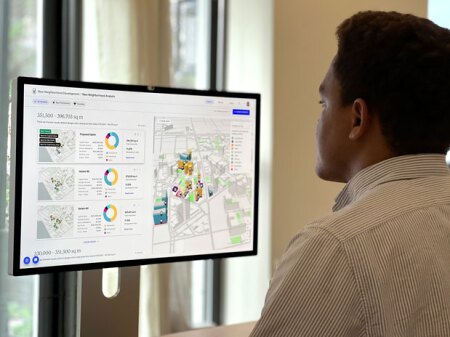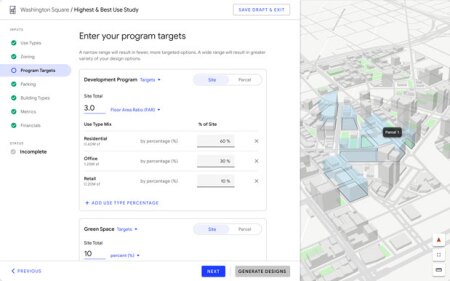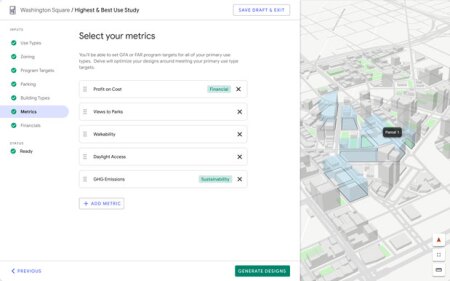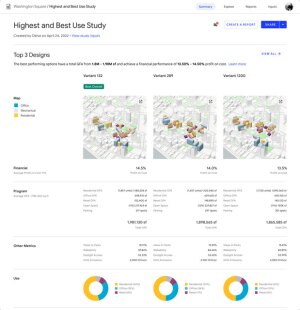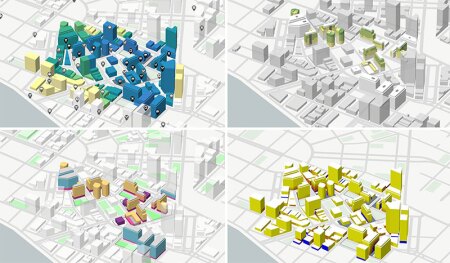After lobbying for two years, Tim Moore, a manager at ULI Boston/New England who conducts technical assistance panels (TAPs), was accepted to “pre-release test” a new self-service version of Delve by Sidewalk Labs. Pre-release testing allows Delve to receive targeted feedback from qualified users before the product reaches a wider range of users.
Launched in fall 2020, Delve is an evaluation tool that uses artificial intelligence, Geographic Information System (GIS), and user input to optimize real estate development. Currently available on an engagement model, Delve pairs users with a team of consultants to generate highest and best use design options and help find design solutions for the nuances of complex projects. An updated version, Delve 2.0, will be released later this year.
Okalo Ikhena, the director of product management leading Delve, says, “One of the biggest values of Delve is its speed and automation.” The product rapidly accelerates the pre-development process by creating design optionality and quantifying designs from quality-of-life, sustainability, regulatory, and financial perspectives in a matter of minutes. “And you can do all of this in parallel while it generates up to thousands of design options. It then ranks and filters design priorities based on your inputs to surface the top-performing options to explore further,” he says.
Moore believes that Delve has the potential to transform how real estate stakeholders perform feasibility studies and make development design decisions by cutting down on soft costs and saving up to years of time in pre-development stages.
Urban Land sat down over Google Meet with Moore and Ikhena for an inside look at the cutting-edge real estate and land use tool.
UL: What was the impetus for creating Delve? What inspired it?
OKALO IKHENA: Sidewalk Labs was Alphabet’s urban innovation company and is now a unit within Google, with the same mission to build products that radically improve quality of life in cities for all.
The impetus was Sidewalk Labs’ understanding of the commercial real estate development process. Historically, particularly in the early feasibility and conceptual design phases, the process has been time consuming, manual, and a rinse-and-repeat model. This doesn’t necessarily lead to the best placemaking outcomes or the best returns for developers. The potential missed opportunities or unintended consequences can have lasting impacts on communities.
Sidewalk Labs released a prototype generative design tool to help development teams identify enhanced design options with better ROI than time and cost constraints typically allow. A year later, Delve launched as a product for developers, architects, and cities to improve the real estate development process with radically better design.
UL: How did you become interested in pre-releasetesting Delve 2.0?
TIMOTHY MOORE: In my previous roles working with investors and developers in opportunistic markets, I realized there was a disconnect between real estate developers trying to make the most profitable product and those trying to make the best product for the neighborhood. One of the challenges here is to consider the soft costs associated with what you want to do. So, when I first saw Delve, I was impressed that we could put in our parameters and constraints and have it generate hundreds of options to accomplish our goals through real estate development. Delve poses real value in limiting the costs for developers and the investors while also figuring out what to prioritize and seeing all the options that might help achieve the same outcome.
Initially, when you apply to be a pre-release tester, the Delve team seeks to learn what you do in real estate. Because I work with a lot of real estate developers and I’m used to GIS and the parcels, all I needed was a lot of different case scenarios in order to experience the functionality of the program. I applied before starting at ULI while I was working for developers, but due to the limited scope of our work, we would only have a couple of parcels to work with at a time that we would want to see a feasibility study on. But through ULI, because my program of focus is Technical Assistance Panels (TAPs), I now have the resources and scope to look at tons of parcels and can put in all sorts of constraints for the real towns we’re doing TAPs for.
UL: When will the fully functioning self-service program go to market and can industry folks still sign up for the testing program?
IKHENA: We’ve worked on multi-acre site projects to large-scale developments that are a thousand-plus acres all across the world through Delve’s engagement model, with the added service layer of a consultant and design team. The launch of Delve 2.0, our fully self-service offering, is imminent in the next few months but will always come with an onboarding process to make sure users know their way around the product. Delve 2.0 will be an out-of-the-box resource that will allow real estate developers, urban planners, project consultants, and architects to engage directly with the software without a Delve consultant navigating the tool for them. We currently have an open testing program, anyone can sign up via this form to participate, subject to availability and a few pre-qualifications.
MOORE: Although Delve is intuitive, I think working with one of the consultants in the beginning will definitely improve your results while you’re getting acclimated to it.
UL: How has user input changed the product during the pre-release phase?
IKHENA: Users have been great at letting us know how our generative algorithms can be more responsive to site conditions and specific contexts. We are working to improve what Delve creates.
We’ve heard great feedback on what matters to developers: faster and more accurate results with fewer initial inputs. We’re building out features to deliver a yield study in less time, while still leveraging the potential of Delve.
Our users have also asked for Delve to expand their expertise. We’re bringing in data sources for zoning and adding in recommendations for building types to do that.
MOORE: Delve takes a holistic view and it’s clear that user feedback has furthered its holistic sophistication.
UL: How is Delve intended to be a gamechanger for the real estate industry?
IKHENA: Developers using Delve are maximizing financial returns while building greener cities with better quality of life. By revealing designs that meet or exceed the competing goals of many stakeholders, Delve takes a step toward building stronger consensus—and stronger cities. The scale of projects that Delve can influence in and of itself is a gamechanger.
MOORE: It’s straightforward. A big part of the time that you’re utilizing pre-development is for feasibility. All that process can go from months to multiple years to get that done because information changes. Delve can generate hundreds of iterations of a property within a day. That’s a big deal, especially in the market like we have now. That can represent significant cost savings when you go to get funding.
With a product like Delve, we really start to narrow down the unintended consequences of what we’re creating. It’s leaps and bounds from where we’ve been the last ten to fifteen years. It really helps you realize the highest and best use of particular parcels of land in a way that wasn’t available previously.
UL: What real estate stakeholders do you see Delve being most useful for and what kind of team would have the most success with it?
IKHENA: Delve has worked with real estate developers, architects, urban planners, and city agencies across the globe. Each stakeholder is looking to optimize for different things. A key benefit is cutting down the amount of time it takes to complete that reconciliation and then having a centralized place for folks to continue to integrate. And for teams that have training gaps or don’t have the personnel for projects that may be of a larger scale or significantly higher complexity, we have the engagement model that lends a Delve consultant to take on some of the nuances.
From one side, real estate developers find Delve valuable as they face a myriad of decisions early in the development process to determine the highest and best use of a site. A development analyst can now take a hands-on approach to creating design options to inform program fit, and then share them with leadership teams who use Delve to guide their decision making. For example, Delve was used to evaluate a 12-acre, mixed-use development to identify design options that could exceed the benchmark. One high-performing Delve variant added nearly 200 units (while also increasing the average size), improved daylight access, and expanded open space.
Architects and urban planners can leverage Delve to accelerate design generation and iterations and optimize existing designs to maximize certain outcomes (e.g., walkability, access to green space, or views). They also can build consensus on a presented design by quantifying the quality-of-life impact and certain sustainability metrics. Delve was used by a lead architect to validate a design scenario to confirm that a proposed scheme struck the right balance between critical quality of life and financial objectives.
Finally, city agencies and municipal design teams may use Delve to measure trade-offs between financial outcomes and quality-of-life impacts of a proposed development. They can quickly and quantitatively compare a proposed plan against other design alternatives and communicate more effectively with developers and community stakeholders. Delve is currently working with cities on critical questions such as “Which sites can be feasibly and profitably developed in the current market?” and “What is the highest and best use for this development parcel?”
MOORE: The technology is extremely innovative, but also requires a human element. The better information you put in with a diverse team, the better information you’re going to get out of it. Delve will autogenerate a simplified pro forma alongside every design option, based on the inputs and constraints that you put into the system.
You’re going to want a standard development team. You’ll want people that are used to the zoning of a certain market who can put in those constraints appropriately. You’re also going to want somebody that knows the performance side because if we know the dollar cost for pre-development and our cost per square foot, Delve can run those numbers more accurately. And then as long as you have the zoning person, you will be able to understand the setbacks.
UL: Are there any new features being developed that you can share with us?
IKHENA: Some of the new features will include smarter, contextually-aware design options. Users will be able to fine-tune a design option and utilize interactive customization of building and product types. Also, we’re looking to add additional zoning data to the automation and the capabilities to create and export custom reports to PDF.
UL: What are the most useful features that you’re most excited about?
MOORE: I love it all. But the most useful is all the different options it generates for each project and the financial models. After you put in your list of priorities and the constraints of the locality, Delve can tell you things like walkability, sunlight hours versus shadows, how many units will have views, access to parks, sustainability, and more.
It can even give you an energy usage report, which is critical to sustainability. It’s exciting to see the many ways in which you can achieve your goals.

